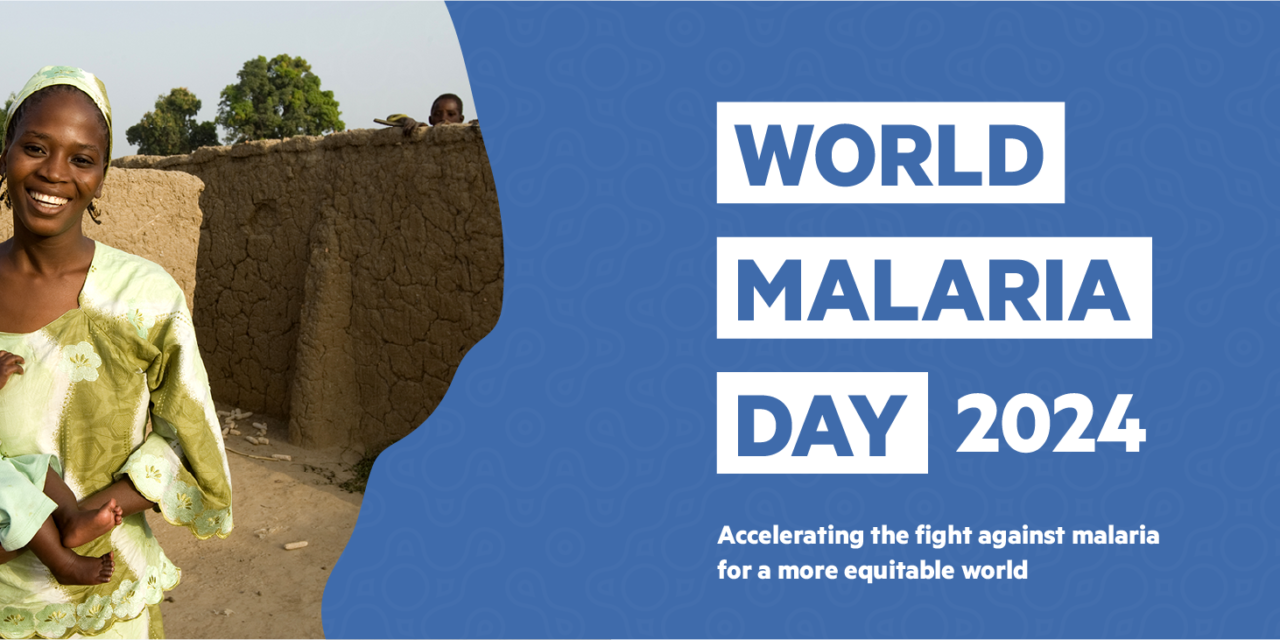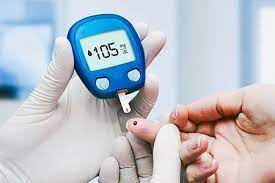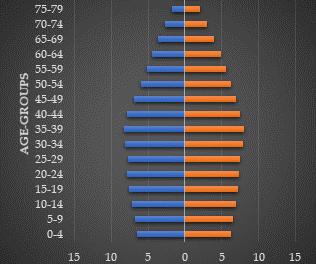World Malaria Day 2024
25 April 2024
“Accelerating the fight against malaria for a more equitable world”
Key facts
- Globally in 2022, there were an estimated 249 million malaria cases and 608 000 malaria deaths in 85 countries.
- The WHO African Region carries a disproportionately high share of the global malaria burden.
- In 2022, the Region was home to 94% of malaria cases (233 million) and 95% (580 000) of malaria deaths.
- Children under 5 accounted for about 80% of all malaria deaths in the Region.
In recent years, progress in reducing malaria has ground to a standstill. Not only does malaria continue to directly endanger health and cost lives, but it also perpetuates a vicious cycle of inequity. People living in the most vulnerable situations including pregnant women, infants, children under 5 years of age, refugees, migrants, internally displaced people, and Indigenous Peoples continue to be disproportionately impacted.
The WHO African Region shoulders the heaviest burden of the disease – accounting, in 2022, for 94% and 95% of malaria case and deaths. Rural populations in the African region living in situations of poverty and with less access to education are the most impacted. In view of the current trajectory, critical 2025 milestones of the WHO global malaria strategy for reductions in malaria cases and deaths will be missed.
Why are pregnant women, young children and other groups in vulnerable situations not accessing the malaria services they need? On World Malaria Day 2024, WHO joins the RBM Partnership to End Malaria and other partners in highlighting barriers to health equity, gender equality and human rights in malaria responses worldwide – as well as concrete measures to overcome them.
Populations at risk of malaria
- Malaria disproportionately affects those in situations of greatest poverty and vulnerability, with young children in the African Region suffering the greatest mortality.
- Refugees, migrants and internally displaced people are at higher risk of malaria, due to limited access to health services, and financial and geographical barriers.
- Migrant populations such as miners, agriculture workers, labourers and soldiers are particularly susceptible to malaria.
- Indigenous Peoples are at high risk of malaria due to the remote locations – far from health services – and conditions in which they often live.
- Pregnant women living in poor, rural areas are disproportionately impacted by malaria.
- Pregnancy reduces women’s immunity to malaria, making them more susceptible to infection and increasing their risk of severe disease and death.
- Malaria infection in pregnancy also carries substantial risks for the fetus and newborn child – including low birthweight, a strong risk factor for neonatal and childhood mortality.
Gender barriers to accessing health services
In malaria-affected communities, barriers to accessing health services may include, for example:
- Lack of decision-making power: in some communities, gender dynamics within a household can hamper a woman’s ability to access prompt malaria prevention and treatment services. Social and cultural norms may require women to receive male approval before using preventive measures such as insecticide-treated nets or seeking care.
- Discriminatory attitudes of healthcare providers: for young women, stigma associated with adolescent pregnancy may create barriers to timely malaria prevention and care.
- Lower literacy rates: some studies have shown that women and girls tend to have less access to information on how to protect themselves from malaria, and how to seek care, due to their comparatively lower literacy levels.
- Humanitarian crises and conflict: in situations of conflict, health services are often compromised and the insecurity can lead to challenges in safely accessing information and care, particularly for women and children.
- Climate change is undermining the social determinants of health by impacting livelihoods, nutrition, migration and security. It contributes to reduced access to essential health services. Taken together, these factors are heightening the risk of malaria-related illness and death, and women and girls are among the groups that are disproportionately impacted.
Boys and men may also experience gender-related health vulnerabilities, heightening their risk of malaria and introducing barriers for access.
- Men working outdoors in forestry, fishing, mining or agriculture may be at greater risk of contracting malaria, especially when their work occurs during peak mosquito biting times around dusk.
- Social and cultural norms of masculinity may discourage boys and men from seeking health care services.
Every human being has the right to the highest attainable standard
of physical and mental health
Malaria responses can be accelerated by applying human rights principles across health services and health system policies. These principles include:
- non-discrimination, equality and inclusion: prioritizing the needs of those furthest behind to achieve equity;
- meaningful participation: the active and informed participation of individuals and communities in health decision-making that affects them;
- accountability: establishing effective mechanisms to monitor progress towards agreed targets.
- transparency: ensuring that states and other actors are transparent in their decision-making processes, including how and what criteria were used to determine priorities in financing, development, implementation, and M&E of health services and programmes.
Equity-oriented primary health care
Countries must reorient health systems towards primary health care to help ensure that:
- people suffering from malaria receive quality health care close to where they live and work;
- communities are fully engaged in the malaria response as care seekers, care providers and in addressing the local factors that increase malaria risk and transmission;
- there is an appropriate focus and action on underlying determinants of the disease – such as education, environment, poverty and gender;
- all malaria control interventions are included in universal health coverages packages that benefit from financial protection through health insurance or other health financing schemes.
To achieve the goal of health for all, it is critically important to monitor health inequalities. Such monitoring can identify populations that are left behind and inform equity-oriented policies, programmes and practices to close existing gaps.
An equity-oriented primary health care approach also entails intersectoral action to address the social and environmental determinants of malaria and fostering community engagement and social participation.
WHO and partner response
To reach the targets of the Global technical strategy for malaria 2016-2030, countries must apply equity-oriented, gender-responsive and human-rights-based approaches. The strategy sets ambitious targets for 2030, compared to a 2015 baseline:
- Reduce case incidence and mortality rates by at least 90%
- Eliminate malaria in at least 35 countries
- Prevent the re-establishment of malaria in all countries that are malaria-free
Equity in access to quality health services is a guiding principle of the strategy, particularly for populations experiencing disadvantage, discrimination and exclusion.
The updated strategy also notes that health systems must be adept not only at delivering quality malaria services but also at “responding in a gender-responsive, equity-oriented and human-rights-based manner.”
Learn more about additional programmes working to reach vulnerable populations:
- The country-led High Burden High Impact approach, catalysed by WHO and the RBM Partnership to End Malaria
- Yaoundé Declaration signed by African Ministers of Health to accelerate malaria mortality reductions in their respective countries
- Mekong Malaria Elimination Programme
Embracing innovation and scaling up WHO-recommended tools
Malaria responses can be strengthened by stepping up investment in the research and development of new tools that benefit all people at risk of the disease, and especially the poorest and most marginalized. Several innovative tools recommended in recent years by WHO will increase health equity for populations at risk of malaria:
- Malaria vaccines: the scale-up of malaria vaccines in Africa through the broad reach of national child immunization platforms will increase access to malaria prevention for vulnerable children – reaching many children who are currently missing out.
- New types of insecticide-treated nets: in March 2023, WHO issued recommendations on a new generation of dual active ingredient insecticide-treated nets that provide greater protection against malaria compared to standard pyrethroid-only nets.












